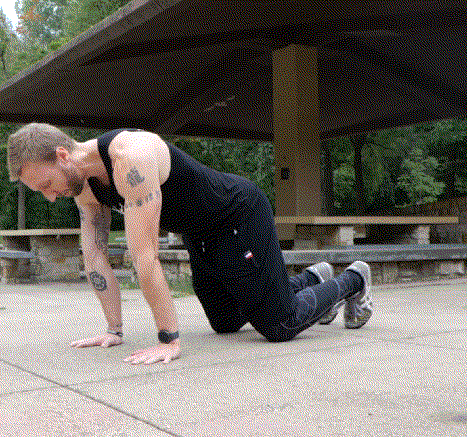Functional Wrist Strength Warm Up Exercises
December 13, 2021 /0 Comments/in Uncategorized /by Chad Zwadlo
The human wrist is kind of a pathetic, weak joint naturally. For us athletes to be able to do the things we want (like handstands, vaults, quadrupedal movement, etc.) it’s very important for us to build good functional strength in the wrists so we don’t injure them. But before any of that, a good warm up for the wrists will get you ready for any strength training or just regular use of the wrists. I’ve been focusing a ton on my wrist conditioning over the last couple years, and here’s a great little wrist warm up for you to use!

Start off in a Table Top position with your hands directly under your shoulders and knees directly under your hips. Your fingers should be pointed straight forward, keep your elbows nice and straight, then lean forward until you feel the stretch in your wrists. While doing this, push into the floor with your fingers to help build functional strength in this position. If you look down at your fingers, you should see your fingertips turning white as you push into them. Do this for 10 to 15 repetitions holding each one in front for a second or so.

In the same position as the last exercise, push into your fingers to lift your palms up off the ground while keeping your first knuckle on the ground. When you first start doing this you probably won’t get very high with the hands and that’s ok! The farther you have your shoulders forward, the harder this exercise will be. So play with the distance and find where you can do it but it’s still a challenge. Hit 10-15 repetitions keeping the elbows nice and straight.

Next, point your fingers to the outside and circle your shoulders around while keeping your elbows straight. As you’re doing this, be sure to push into the ground against the directions your moving to once again build that functional wrist strength. We do this with the thumbs forward and fingers out to strengthen the more stable side of the wrist (the thumb side). You don’t really need to do this with your fingers pointed in and pinky forward because that will focus on the weaker side of the wrist joint (the pinky side) which you really shouldn’t be using much anyway. Make 5-10 circles in each direction before moving on.

Now point the fingers backward, keep your elbows straight and push slightly through the shoulders. Lean back away from your hands until your palms lift off the floor. This will likely feel like a pretty intense stretch when you first start working on this, so take it slow. Do 5-10 moving repetitions before holding the back position for 30 seconds. This will not only build that wrist strength we’re looking for, but also build up some flexibility in this extremely important direction.

This one is a bit strange and may take some practice. Keep in mind this isn’t actually a “stretch” and is just used to move the joint around and increase some fluid inside the joint. Put your hands together and the back of one hand on the ground. From that position you’ll spiral your elbow down to the floor and back up to straight again. You can certainly add some stretching to this movement as well by leaning toward your fingers. I typically will do 10 spirals, then stretch 30 seconds with my elbow rolled one direction, then 5 more spirals and stretch another 30 seconds with my elbow rolled the other way.

Finally, one last back of the hand stretch and conditioning movement. Any time your working on the back side of your wrists, be sure to take things very slowly. It will probably be years of training before you can put any real weight on the back of your wrists and that’s fine, we’re mostly doing it just to stay balanced on both sides of the forearm. Start this one on your knuckles, control the drop down to the back of your wrists with your elbows straight (this is where you’ll feel the stretch), then bend your elbows down to the ground before going back up, stopping for a moment with your elbows straight before lifting back up to the knuckles just to get a little stretch in. Repeat for 10-15 reps.
Building quality functional wrist strength will take a lot of time and commitment. I recommend spending at least 10 to 15 minutes doing these wrist warm up exercises before any workout. You can certainly do these 4 or more times a week. When you first start out be very aware of how your wrists feel throughout the day. You shouldn’t have any consistent wrist pain, even when working on strengthening them. Take it slow, trust the process, and have fun with it!
– Chad Zwadlo







